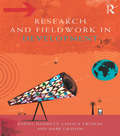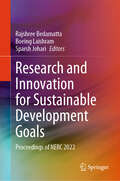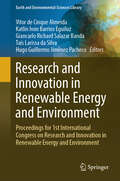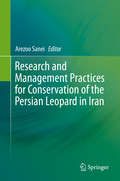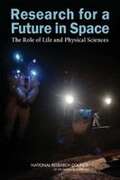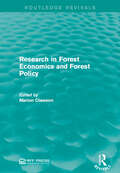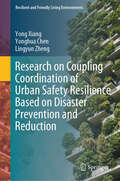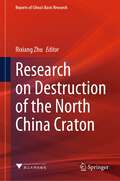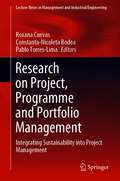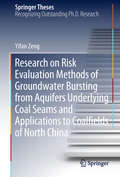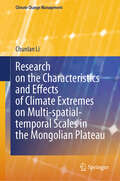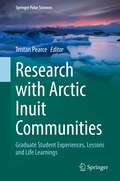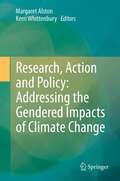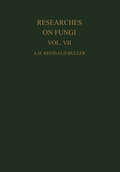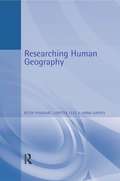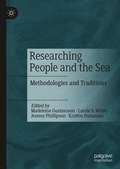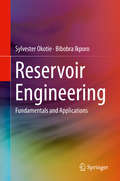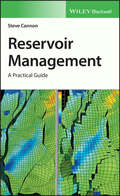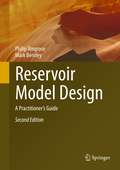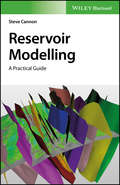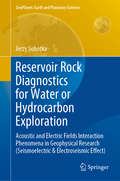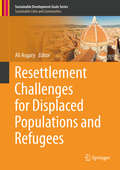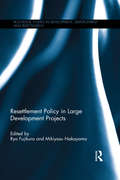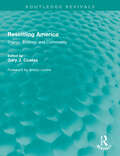- Table View
- List View
Research and Fieldwork in Development
by Daniel Hammett Chasca Twyman Mark GrahamResearch and Fieldwork in Development explores both traditional and cutting edge research methods, from interviews and ethnography to spatial data and digital methods. Each chapter provides the reader with an understanding of the theoretical basis of research methods, reflects upon their practice and outlines appropriate analysis techniques. The text also provides a cutting edge focus on the role of new media and technologies in conducting research. The final chapters return to a set of broader concerns in development research, providing a new and dynamic set of engagements with ethics and risk in fieldwork, integrating methods and engaging development research methods with knowledge exchange practices. Each chapter is supported by several case studies written by global experts within the field, documenting encounters and experiences and linking theory to practice. Each chapter is also complimented by an end of chapter summary, suggestions for further reading and websites, and questions for further reflection and practice. The text critically locates development research within the field of international development to give an accessible and comprehensive introduction to development research methods. This book provides an invaluable overview to the practice of international development research and serves as an essential resource for undergraduate and postgraduate student embarking of development fieldwork. It is supported by online resources including extended bibliographies for each chapter, example risk and ethic forms, example policy briefing notes, research reports, links to websites and data sources.
Research and Innovation for Sustainable Development Goals: Proceedings of NERC 2022
by Boeing Laishram Rajshree Bedamatta Sparsh JohariAlmost immediately after the UN Secretary-General called for a Decade of Action to deliver Sustainable Development Goals at the SDG Summit of 2019, the world faced massive COVID-19 induced disruptions at the cost to the global economy. To accelerate progress in the SDGs, the decade of 2020-2030 requires research, innovations, and commitments of various stakeholders at all levels – locally, nationally, and globally. This book contributes to the action agenda by focusing on India's opportunities and challenges, emphasizing India's northeast. Many countries have taken significant actions toward realizing the SDG mission and vision. However, due to a lack of knowledge, research, and innovation, there is a considerable disparity in the countries' actions. Few developed countries have made significant progress in realizing the SDGs, while many developing countries struggle. This book brings together diverse views on various domains of SDGs, providing a sub-national framework for addressing the gaps and meeting the goals.
Research and Innovation in Renewable Energy and Environment: Proceedings for 1st International Congress on Research and Innovation in Renewable Energy and Environment (Earth and Environmental Sciences Library)
by Vitor de Cinque Almeida Katlin Ivon Barrios Eguiluz Giancarlo Richard Salazar Banda Taís Larissa da Silva Hugo Guillermo Jiménez PachecoRenewable energies reduce dependence on fossil fuels and minimize the carbon footprint. Solar panels and wind turbines decrease emissions and costs in the industry. Socially, they benefit disconnected communities, improving quality of life and providing opportunities. Sustainable development seeks equity and social inclusion, driving sustainable energy solutions. Renewable energies promote a prosperous and equitable future, addressing environmental and economic challenges. The energy transition is everyone's responsibility to ensure a greener and brighter tomorrow. On the other hand, environmental biotechnology and marine biology are fundamental to address environmental challenges. Research on treating effluents from the dairy, textile, and mining sectors seeks solutions to reduce water pollution. Industrial waste valorization through biotechnology aims to decrease pollution and resource depletion. The production of bio-products, biomaterials, bioplastics, and biofuels offerssustainable alternatives with a lower carbon footprint. Marine biology focuses on understanding and conserving aquatic ecosystems in the face of climate change and human influence. Biotechnology also contributes to the sustainable use of national biodiversity, with applications in pharmaceutical, cosmetic, and agricultural industries. These multidisciplinary fields are advancing towards a more sustainable and environmentally friendly future. The conference proceedings will consist of original research articles, reviews, and short communications covering several types of renewable energies: Solar including photovoltaic cells or solar thermal systems, Wind, Hydropower, Biomass-based energy, Geothermal, Waves Energy, Hydrogen, Bioenergy, or energy from biological processes, and fuel cell systems. In addition, studies focused on Environmental Biotechnology, including Bioremediation, Bioenergy Production, Microbial Fuel Cells, Waste Valorization, Microplastic Biodegradation, Biodegradable Materials and Phytoremediation, as well as focused on Marine Biology, including Marine Biodiversity and Conservation, Marine Genomics, Ocean Acidification, Marine Ecotoxicology, and Marine Biotechnology and Microbiology. Other environmental areas of research can be also included such as industrial wastewater systems or the development of sustainable solutions for a healthier and more resilient environment.
Research and Management Practices for Conservation of the Persian Leopard in Iran
by Arezoo SaneiThe population of the Persian leopard (Panthera pardus saxicolor) has drastically declined; this Asian leopard subspecies has disappeared from some parts of its former range. Containing large areas of potential habitats with leopard presence across almost all of its provinces, Iran is known to be the last stronghold for the Persian leopard in the region. This book comprehensively covers research, management and conservation practices of the Persian leopard, including:· The first phase of the Persian Leopard National Action Plan in Iran together with an innovative leopard insurance program and a contingent valuation practice with respect to the wildlife trafficking law enforcement in Iran· Research on a hypothesis about the risk of a major fragmentation and splitting the leopard distribution range in Iran into a northern and a southern parts· An innovative and empirically fitted species- and region-specific approach for assessing the cumulative effect of land use and land cover changes on the leopard persistence· Distribution modeling of leopard potential habitats on a regional basis, accompanied by ground validation techniques· An evaluation to three threshold rules to define the habitat suitability indices· Persian leopard habitats and relative corridors in the trans-boundary areas of the East Azarbaijan province of the northwest of Iran in the Caucasus Ecoregion. The innovative research and conservation approaches presented in this book will be of great interest to those studying the leopard and other large carnivore species. The innovative models presented in this book about cumulative effect of the land use and land cover changes will be beneficial to land use managers, planners and decision makers in selecting wildlife friendly solutions for development programs. The strategic and action planning model as well as the leopard compensation program as an insurance scheme are developed specifically for the local condition and leopard status in Iran.
Research for a Future in Space: The Role of Life and Physical Sciences
by Committee for the Decadal Survey on Biological Physical Sciences in SpaceDuring its more than 50-year history, NASA's success in human space exploration has depended on the agency's ability to effectively address a wide range of biomedical, engineering, physical sciences, and related obstacles. This achievement is made possible by NASA's strong and productive commitments to life and physical sciences research for human space exploration, and by its use of human space exploration infrastructures for scientific discovery. Research for a Future in Space: The Role of Life and Physical Sciences explains how unique characteristics of the space environment can be used to address complex problems in the life and physical sciences. This booklet also helps deliver both new knowledge and practical benefits for humankind as it embarks on a new era of space exploration. Research for a Future in Space: The Role of Life and Physical Sciences is based on the in depth report, Recapturing a Future for Space Exploration: Life and Physical Sciences Research for a New Era. To learn more about the future of space exploration, visit our catalog page and download this report for free.
Research in Forest Economics and Forest Policy (Routledge Revivals)
by Marion ClawsonIn order to fill a growing need for research into forestry issues, Resources for the future held a symposium in 1977.Orignally published in the same year, all papers in this collection were written specifically for this symposium to highlight the most important forestry issues including pricing policy, supply and demand and the role of the public and private forestry sector. This title will be of interest to Environmental Students and professionals.
Research on Coupling Coordination of Urban Safety Resilience Based on Disaster Prevention and Reduction (Resilient and Friendly Living Environments)
by Yong Xiang Yonghua Chen Lingyun ZhengThis book examines the connotations of the urban safety resilience system and the operational mechanisms of its subsystems. By employing a coupled coordination model, we conduct evaluative analyses across the personnel-facility-management dimensions of urban safety resilience. We provide a comprehensive perspective to help readers understand how disaster risk reduction theories can be applied to various subsystems of urban safety resilience, optimizing disaster management measures in different cities. This book is intended to provide practical guidance for urban planners, policymakers, and researchers, while also being accessible to general readers interested in urban development. The extensive experience and in-depth research of the author's team make this book a valuable reference for those seeking to explore urban safety resilience.
Research on Destruction of the North China Craton (Reports of China’s Basic Research)
by Rixiang ZhuThis book mainly introduces overview of “Destruction of the North China Craton”, a major research plan of NSFC. It summarizes the scientific ideas, core key scientific issues, scientific research objectives, and models of the major research plan of "Destruction of the North China Craton". From the perspective of major national needs and scientific discipline development, the book focuses on the following aspects: the temporal and spatial distribution range, process, and mechanism of the NCC destruction; the properties, structure, and interaction of materials in different spheres in the earth during craton destruction; the shallow effect of craton destruction; and the control mechanism of mineral resources, energy, and disasters. The book also makes a strategic prospect for the study of global dynamics and improves human understanding of the formation and evolution of continents.
Research on Project, Programme and Portfolio Management: Integrating Sustainability into Project Management (Lecture Notes in Management and Industrial Engineering)
by Roxana Cuevas Constanta-Nicoleta Bodea Pablo Torres-LimaThis book collects recent work presented at the 31st IPMA Congress, which was held in Merida, Mexico, from September 30th to October 2nd, 2019. It covers a range of project, programme and portfolio management contexts, with the general aim of integrating sustainability into project management.The book is structured into three parts. The first part covers concepts and approaches related to the integration of sustainability in project management. The second part presents research on integrating sustainability into project management in different industries and regions. The final part takes specific perspectives on integrating sustainability into project management related to learning and continuing competence development. The book offers a valuable resource for all researchers interested in studying the emerging trends in incorporating sustainability in project, programme and portfolio management.
Research on Risk Evaluation Methods of Groundwater Bursting from Aquifers Underlying Coal Seams and Applications to Coalfields of North China (Springer Theses)
by Yifan ZengThis book provides an information fusion model with information fusion theory, geographic information system technology and modern mathematical methods to evaluate the risks of groundwater inrushes from aquifers underlying coal seams. In this new model, the water inrush vulnerable index was calculated with variable weights theory. It overcomes the defect of the traditional vulnerability index method that assumes constant weights for the factors controlling the water inrush. Mine water inrush events often occur during coal mine construction and production; they account for a large proportion of the nation’s coal mine disasters and accidents in China. Between 2005 and 2014, 513 water inrush incidents have occurred with a total loss of 2,753 lives. As mining depths and mining intensity continue to increase, the hydrogeological conditions encountered are becoming more complex. The innovative model presented here was applied to two coal mines in China with proved better results than the traditional vulnerability index method.
Research on the Characteristics and Effects of Climate Extremes on Multi-spatial-temporal Scales in the Mongolian Plateau (Climate Change Management)
by Chunlan LiCompared with average climate changes, climate extremes which are considered as low-probability events have greater impacts on natural and social systems due to their suddenness, unpredictability and strong destructiveness. Located in the typical arid–semiarid climate transition zone, the Mongolian Plateau, dominated by herbage animal husbandry, is greatly affected by climate extremes, and its ecosystem is extremely fragile. In the context of global warming, the spatial-temporal variation research about climate extremes and their impacts on vegetation is not only beneficial to the protection of the grassland ecological environment in the Mongolian Plateau, but also of great significance to formulate an effective meteorological disaster risk management.Based on daily highest temperature, daily minimum temperature and daily precipitation dataset of 111 meteorological stations over Mongolian Plateau from 1961 to 2014. Firstly, sixteen extreme temperature indices and eleven extreme precipitation indices were calculated. Then, multi-spatial-temporal characteristics of climate extremes in the scope of intensity, duration and frequency were analyzed. At the same time, the vegetation variations were analyzed based on GIMMS NDVI3g data. Thirdly, correlation analysis and multiple stepwise regression analysis were used to analyze the relationships between extreme climate indices and NDVI in different spatial scales from the perspective of single factor and multiple factors, respectively. Finally, the future change of climate extremes in duration were explored based on the climate model data. At the same time, the vulnerable areas of grassland and forest were also identified, and adaptive options of different scales were proposed.Researchers engaged in extreme climate change and managers of government departments are the readership/primary audience for the work.
Research with Arctic Inuit Communities: Graduate Student Experiences, Lessons and Life Learnings (Springer Polar Sciences)
by Tristan PearceThis book shares graduate student experiences, lessons, and life learnings from research with Inuit communities in the Canadian Arctic. The results of graduate student research are often disseminated in a thesis or dissertation, but their personal experiences building relationships with Inuit, working together to design and conduct research, and how this shaped their research approach and outcomes, are rarely captured. As such, there are limited resources available to new researchers that share information about the practical aspects of community-based research in the Arctic. The book is intended to provide a glimpse into what it is like to do research together with Inuit, and in doing so, contribute to the development of more productive and equitable relationships between Inuit and researchers. The chapters are written as structured narratives in the first-person and include reflections, and lessons learned.
Research, Action and Policy: Addressing the Gendered Impacts of Climate Change
by Kerri Whittenbury Margaret AlstonResearch, Action and Policy: Addressing the Gendered Impacts of Climate Change presents the voices of women from every continent, women who face vastly different climate events and challenges. The book heralds a new way of understanding climate change that incorporates gender justice and human rights for all.
Researches on Fungi, Vol. VII: The Sexual Process in the Uredinales
by A. H. BullerThis is the last volume of the late Professor Buller's monumental work on Fungi. Before his death in 1943, Dr. Buller had completed the manuscript; the final preparation for press has been made by Dr. G.R. Bisby of the Imperial Mycological Institute, Kew. Publication of the volume has been sponsored by the Royal Society of Canada, and the work of proofreading undertaken by Dr. W.E. Hanna, Dr. J.H. Craigie, and Dr. F.L. Drayton; the index has been prepared under Dr. Hanna's supervision. A foreword has been contributed by Dr. Joseph A. Pearce, President of the Royal Society.
Researching Human Geography
by Anna Davies Loretta Lees Keith HoggartResearching Human Geography is an essential new text for any geography student about to embark on a research project. An understanding of how different theories of knowledge have influenced research methodologies is crucial in planning and designing effective research; this book makes this link clear and explores how various philosophical positions, from positivism to post-structuralism, have become associated with particular methodologies.The book gives an overview of a wide range of methods and data collection, both quantitative and qualitative, and explores their strengths and weaknesses for different kinds of research. 'Researching Human Geography' also looks at the various techniques available for the analysis of data, which is presented as an integral and ongoing part of the research process. Clearly written, with extensive use of examples from previous research to show 'methodology in action', this new text is an invaluable addition to both the theory and method of research in human geography.
Researching People and the Sea: Methodologies and Traditions
by Madeleine Gustavsson Carole S. White Jeremy Phillipson Kristen OunanianIn this unique edited collection, social scientists reflect upon and openly share insights gathered from researching people and the sea. Understanding how people use, relate to and interact with coastal and marine environments has never been more important, with social scientists having an increasingly vital contribution to make. Yet practical experiences in deploying social science approaches in this field are typically hidden away in field notes and unpublished doctoral manuscripts, with the opportunity for shared learning that comes from doing research often missed. There is a need for reflection on how social science knowledge is produced. This collection presents experiences from the field, its necessary reflexivity and innovation in methods, and the challenges and opportunities of translating across disciplines and policy. It brings to light the tacit expertise needed to study people and the sea and offers lessons which readers could employ in their own research. With a focus on the future direction of marine social sciences, the volume is highly relevant to masters and doctoral students and more experienced researchers engaged in studying people and the sea, as well as policy makers, practitioners and scientists wishing to understand the social dimension of marine and coastal environments. Chapters 2 and 3 are available open access under a Creative Commons Attribution 4.0 International License via link.springer.com.
Reservoir Engineering: Fundamentals and Applications
by Sylvester Okotie Bibobra IkporoThis book provides a clear and basic understanding of the concept of reservoir engineering to professionals and students in the oil and gas industry. The content contains detailed explanations of key theoretic and mathematical concepts and provides readers with the logical ability to approach the various challenges encountered in daily reservoir/field operations for effective reservoir management. Chapters are fully illustrated and contain numerous calculations involving the estimation of hydrocarbon volume in-place, current and abandonment reserves, aquifer models and properties for a particular reservoir/field, the type of energy in the system and evaluation of the strength of the aquifer if present. The book is written in oil field units with detailed solved examples and exercises to enhance practical application. It is useful as a professional reference and for students who are taking applied and advanced reservoir engineering courses in reservoir simulation, enhanced oil recovery and well test analysis.
Reservoir Geomechanics
by Mark D. ZobackA practical reference for geoscientists and engineers in the petroleum and geothermal industries.
Reservoir Management: A Practical Guide
by Steve CannonReservoir management is fundamental to the efficient and responsible means of extracting hydrocarbons, and maximising the economic benefit to the operator, licence holders and central government. All stakeholders have a social responsibility to protect the local population and environment. The process of managing an oil or gas reservoir begins after discovery and continues through appraisal, development, production and abandonment; there is cost associated with each phase and a series of decision gates should be in place to ensure that an economic benefit exists before progress is made. To correctly establish potential value at each stage it is necessary to acquire and analyse data from the subsurface, the planned surface facilities and the contractual obligations to the end-user of the hydrocarbons produced. This is especially true of any improved recovery methods proposed or plans to extend field life. To achieve all the above requires a multi-skilled team of professionals working together with a clear set of objectives and associated rewards. The team’s make-up will change over time, as different skills are required, as will the management of the team, with geoscientists, engineers and commercial analysts needed to address the issues as they arise. This book is designed as a guide for non-specialists involved in the process of reservoir management, which is often treated as a task for reservoir engineers alone: it is a task for all the disciplines involved in turning a exploration success into a commercial asset. Most explorers earn their bonus based on the initial estimates of in-place hydrocarbons, regardless of the ultimate cost of production; the explorers have usually moved on to a new basin before the first oil or gas is produced! This book is not a deeply academic tome, rather the description of a process enlivened by a number of stories and case studies from the author’s forty years of experience in the oil-patch.
Reservoir Model Design: A Practitioner's Guide
by Philip Ringrose Mark BentleyThis book gives practical advice and ready to use tips on the design and construction of subsurface reservoir models. The design elements cover rock architecture, petrophysical property modelling, multi-scale data integration, upscaling and uncertainty analysis. Philip Ringrose and Mark Bentley share their experience, gained from over a hundred reservoir modelling studies in 25 countries covering clastic, carbonate and fractured reservoir types, and for a range of fluid systems – oil, gas and CO2, production and injection, and effects of different mobility ratios. The intimate relationship between geology and fluid flow is explored throughout, showing how the impact of fluid type, displacement mechanism and the subtleties of single- and multi-phase flow combine to influence reservoir model design.The second edition updates the existing sections and adds sections on the following topics:· A new chapter on modelling for CO2 storage· A new chapter on modelling workflows· An extended chapter on fractured reservoir modelling· An extended chapter on multi-scale modelling· An extended chapter on the quantification of uncertainty· A revised section on the future of modelling based on recently published papers by the authorsThe main audience for this book is the community of applied geoscientists and engineers involved in understanding fluid flow in the subsurface: whether for the extraction of oil or gas or the injection of CO2 or the subsurface storage of energy in general. We will always need to understand how fluids move in the subsurface and we will always require skills to model these quantitatively. The second edition of this reference book therefore aims to highlight the modelling skills developed for the current energy industry which will also be required for the energy transition of the future. The book is aimed at technical-professional practitioners in the energy industry and is also suitable for a range of Master’s level courses in reservoir characterisation, modelling and engineering.• Provides practical advice and guidelines for users of 3D reservoir modelling packages• Gives advice on reservoir model design for the growing world-wide activity in subsurface reservoir modelling• Covers rock modelling, property modelling, upscaling, fluid flow and uncertainty handling• Encompasses clastic, carbonate and fractured reservoirs • Applies to multi-fluid cases and applications: hydrocarbons and CO2, production and storage; rewritten for use in the Energy Transition.
Reservoir Modelling: A Practical Guide
by Steve CannonThe essential resource to an integrated approach to reservoir modelling by highlighting both the input of data and the modelling results Reservoir Modelling offers a comprehensive guide to the procedures and workflow for building a 3-D model. Designed to be practical, the principles outlined can be applied to any modelling project regardless of the software used. The author — a noted practitioner in the field — captures the heterogeneity due to structure, stratigraphy and sedimentology that has an impact on flow in the reservoir. This essential guide follows a general workflow from data QC and project management, structural modelling, facies and property modelling to upscaling and the requirements for dynamic modelling. The author discusses structural elements of a model and reviews both seismic interpretation and depth conversion, which are known to contribute most to volumetric uncertainty and shows how large-scale stratigraphic relationships are integrated into the reservoir framework. The text puts the focus on geostatistical modelling of facies and heterogeneities that constrain the distribution of reservoir properties including porosity, permeability and water saturation. In addition, the author discusses the role of uncertainty analysis in the static model and its impact on volumetric estimation. The text also addresses some typical approaches to modelling specific reservoirs through a mix of case studies and illustrative examples and: Offers a practical guide to the use of data to build a successful reservoir model Draws on the latest advances in 3-D modelling software Reviews facies modelling, the different methods and the need for understanding the geological interpretation of cores and logs Presents information on upscaling both the structure and the properties of a fine-scale geological model for dynamic simulation Stresses the importance of an interdisciplinary team-based approach Written for geophysicists, reservoir geologists and petroleum engineers, Reservoir Modelling offers the essential information needed to understand a reservoir for modelling and contains the multidisciplinary nature of a reservoir modelling project.
Reservoir Rock Diagnostics for Water or Hydrocarbon Exploration: Acoustic and Electric Fields Interaction Phenomena in Geophysical Research (Seismoelectric & Electroseismic Effect) (GeoPlanet: Earth and Planetary Sciences)
by Jerzy SobotkaThis book presents a study that establishes a set of diagnostic parameters for characterizing the behavior of a geological medium stimulated by external fields and their interactions as a physical basis for developing new methods in exploration geophysics. It describes in detail the investigation methods and instruments (including laboratory, field and borehole devices), and discusses experimental, field and modeling investigations of the interaction of mechanic/electromagnetic fields in reservoir rocks. Lastly, the book also evaluates and the proposed methodology and demonstrates its effectiveness using case studies in which certain geophysical diagnostic/exploration problems have been solved.
Resettlement Challenges for Displaced Populations and Refugees (Sustainable Development Goals Series)
by Ali AsgaryThe main focus of this book is to help better understand the multidimensionality and complexity of population displacement and the role that reconstruction and recovery knowledge and practice play in this regard. According to the UN Refugee Agency (UNHCR), the total number of people forcibly displaced due to wars and conflicts, disasters, and climate change worldwide, exceeded 66 million in 2016. Many of these displaced populations may never be able to go back and rebuild their houses, communities, and businesses.This text brings together recovery and reconstruction professionals, researchers, and policy makers to examine how displaced populations can rebuild their lives in new locations and recover from disasters that have impacted their livelihoods, and communities. This book provides readers with an understanding of how disaster recovery and reconstruction knowledge and practice can contribute to the recovery and reconstruction of displaced and refugee populations. This book will appeal to students, researchers, and professionals working in the field.
Resettlement Policy in Large Development Projects (Routledge Studies in Development, Displacement and Resettlement)
by Ryo Fujikura Mikiyasu NakayamaHydropower generation by construction of large dams attracts considerable attention as a feasible renewable energy source to meet the power demand in Asian cities. However, large development projects cause involuntary resettlement. Of the world’s forty to eighty million resettlers, many resettlers have been unable to rebuild their livelihood after relocation and have become impoverished. This book uniquely explores the long-term impacts of displacement and resettlement. It shows that long-term post-project evaluation is necessary to assess the rehabilitation and livelihood reconstruction of resettlers after relocation. It focuses on large dam projects in a number of Asian countries, including Indonesia, Japan, Laos, Turkey, Sri Lanka and Vietnam, which are often ignored in Displacement studies in favour of China or India. Drawing on a wealth of empirical data over ten years, it presents crucial factors for successful resettlement by analysing lessons learned. The range of countries allow for a diverse and complex set of factors and outcomes to be analysed. Many of the factors for successful resettlement recur despite the cases being different in implementation period and location. The book presents highly original findings gathered by local researchers in the field directly talking to resettlers who were relocated more than a decade ago. This original book is a unique resource for researchers and postgraduate students of development studies, environment, geography, sociology and anthropology. It also makes policy recommendations for future resettlement programs that are of great value to development policy makers, planners, water resources engineers and civil society protest groups.
Resettling America: Energy, Ecology and Community (Routledge Revivals)
by Gary J. CoatesEvery movement has its bellweathers, the ideas that lead the way and rally its adherents towards a set of shared values and visions. Resettling America was one such beacon – a publication for its time and ahead of its time. Those of us doing the work of sustainability and the transformation of communities feel grateful for Gary’s early and prescient contribution that has shaped the thinking of so many around the US and beyond. Essential reading for all green warriors! Jason F. McLennan, Chief Sustainability Officer – Perkins & Will. Founder, Living Building Challenge. Originally published in 1981 and now reissued with a new Preface by Gary J. Coates, Resettling America was one of the first comprehensive, transdisciplinary books on the crisis of sustainability and the implications of that crisis for the re-design of buildings, towns, cities and regions. Through essays by Coates, which provide a theory of ecological design, and case studies written by leading authors and activists of the time, the book presents a strategic vision of how it would be possible to create a sustainable and livable society through a process of cooperative community development rooted in a radical re-visioning of nature, self and society. By providing a strategic vision, as well offering practical means for creating a sustainable society worth sustaining, Resettling America remains more relevant and inspiring than ever to those who face the ecology of crises that now surround us in the 21st Century.
